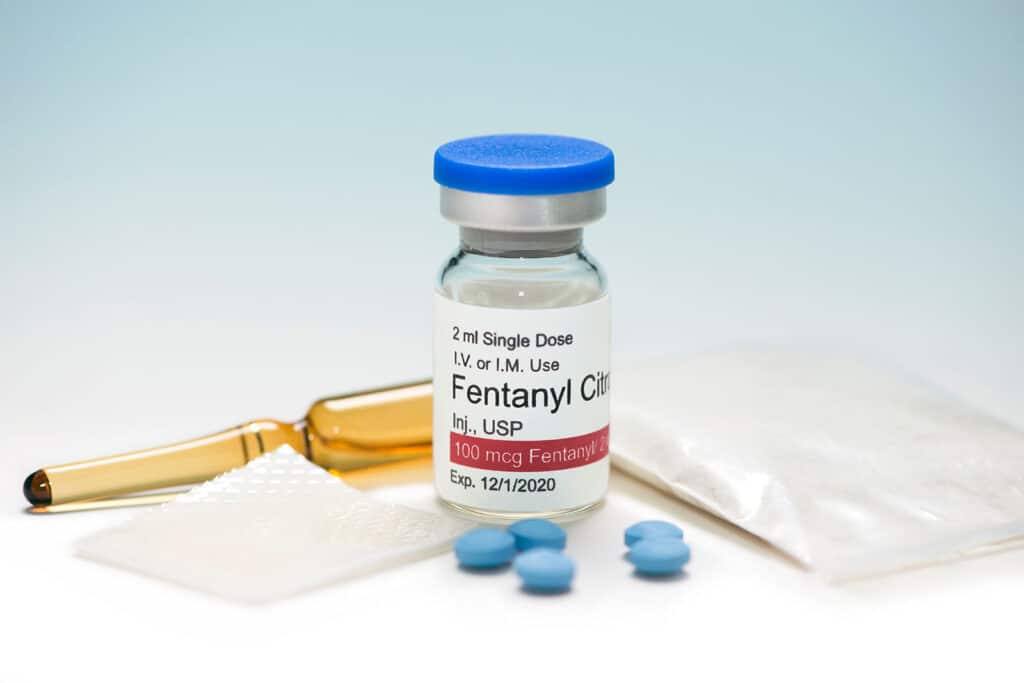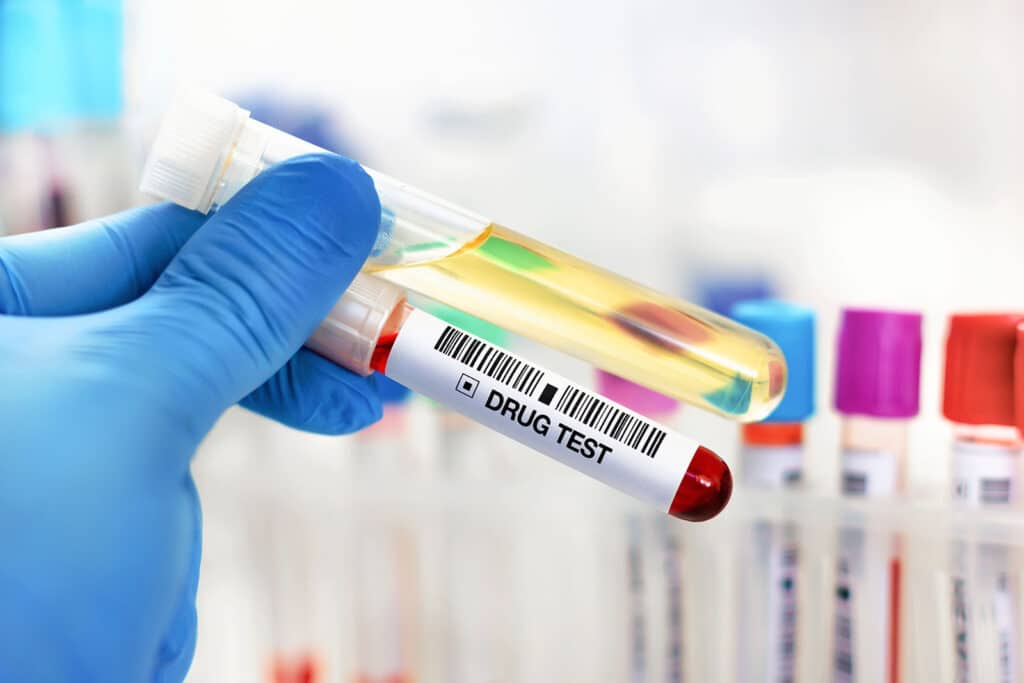If you’re wondering how long fentanyl stays in the system, then you should read further. Fentanyl usually shows up on a urine test for 24 to 72 hours. While hair tests can detect fentanyl for up to three months. While a blood test can detect fentanyl between 5 to 48 hours upon ingestion, and will depend on the dose of fentanyl ingested.
However, saliva tests are not accurate enough to detect the presence of fentanyl. If you want to know more information on how long fentanyl stays in your system, then you should read further.
Table of Contents
What Is Fentanyl?
Fentanyl is a potent drug that is similar to morphine. Physicians prescribe this drug to relieve pain due to cancer. These are also the prescribed painkillers for chronic pain when less potent opioids could not achieve the desired effect. Doctors often prescribe this medication to relieve pain after their patients undergo surgery.

Although it is similar to morphine, fentanyl is an opiate that is 50 to 100 times more powerful than morphine. Fentanyl is a prescription medication that physicians prescribe for severe pain, but illicit drug manufacturers also create it in the lab for sale on the street. In 2014, fentanyl overdose deaths began to increase steadily; in 2020, 56,526 people died of a fentanyl overdose. That’s why fentanyl abuse has increasingly become a cause of concern over the past several years.
The number of deaths from prescription opioids also remained high and peaked in 2017 at 17,029. In 2020, overdose deaths decreased slightly to 16,416. To make matters worse, illicit drug manufacturers have been adding MDMA, methamphetamine, cocaine, and heroin to fentanyl doses. They are doing this because it doesn’t require much fentanyl to create the desired high.
Because of this, fentanyl is cheaper than other substances, but trouble can begin because these dealers are not informing their customers that they are spiking their doses of fentanyl with other substances. Therefore, customers would be unaware that they are taking larger doses of opioids than they believed, which can cause them to overdose on these drugs.
How Does Fentanyl Work?
Fentanyl works by attaching to the brain’s opioid receptors, like heroin or morphine. These areas in the brain control a person’s emotions and regulate pain. While fentanyl interacts with these receptors, it causes the brain to release larger doses of dopamine. Dopamine comes from neurons within the brain’s reward center. The increase in dopamine is believed to be what causes the user to experience the euphoria of fentanyl high.
Fentanyl causes euphoria, but it can also cause the user’s breathing to slow down, increasing the risk that the person will experience an overdose. If this doesn’t occur and the person continues to ingest fentanyl regularly, the brain will adapt to the presence of fentanyl, so it won’t be as sensitive to the drug as it used to be. When this occurs, the user begins to lose the ability to feel pleasure from activities other than ingesting fentanyl. This is known as “tolerance,” leading to fentanyl addiction.

What Are the Detection Times for Fentanyl, and What Affects Them?
The detection times for fentanyl on drug tests differ. It will depend on the dose, and the type of drug test (hair, blood, or urine sample). After you ingest fentanyl, it will remain in your system based on the following factors:
Did you take other substances with fentanyl?
If you use other substances at the same time that you are using fentanyl, the other substances will affect how your body metabolizes fentanyl. The commonly mixed drugs with fentanyl are cocaine, heroin, methamphetamine, or a prescription drug. Mixing fentanyl with other drugs is extremely dangerous and life-threatening.
How often do you use fentanyl, and how long do you use it?
The length of time you use fentanyl and how often you use it can cause the substance to remain in your system for longer. The longer you’ve been using fentanyl, the longer it will stay in your system. Even long-term use of a fentanyl patch can remain in your system.
How did you use fentanyl?
If you ingest fentanyl intravenously, the substance will be eliminated faster than if you ingest the drug by other methods. Oral and transdermal fentanyl is also available.
How much did you take?
Taking a large dose of fentanyl will remain in your system longer than a smaller one. Even if you’ve been taking fentanyl for a short amount of time, but have taken too much dose, it will still remain in your system.
Is your liver functioning properly?
If your liver is not functioning adequately, this will cause it to take a more extended period of time to metabolize fentanyl. That’s why people who drug abuse fentanyl and who have a liver disease like cirrhosis, will have fentanyl in their system longer.
What about genetics?
Some people are unable to metabolize fentanyl efficiently because of poor enzymatic function. The enzyme CYP3A4 does most of the work metabolizing fentanyl.
What are your body mass index, body fat, and weight?
If you have more body fat than another user, your body will metabolize fentanyl slower. Scientists believe this occurs because the body redistributes the fentanyl to fat tissue.
What is your age?
If you are older, fentanyl takes longer to be eliminated from the body than in a younger user. Age does affect how the body metabolizes fentanyl.

How Long Does Fentanyl Stay in Your System?
The following advanced specimen drug test can detect fentanyl in your system:
- Hair: Detects fentanyl for up to 90 days.
- Saliva: Detects fentanyl for one to three days.
- Blood: Detects fentanyl for up to 12 hours.
- Urine: Detects fentanyl for 24 to 72 hours.
For chronic or heavy users, this detection window can be extended. While it’s difficult to specify an exact number of days, fentanyl can be detectable in urine for several days beyond the standard 72-hour window. In some cases, this could mean up to 5-7 days or potentially longer, depending on the factors mentioned earlier (dosage, frequency of use, individual metabolism, body composition, and overall health).
Fentanyl’s half-life
Fentanyl has been a powerful synthetic opioid used in anesthesiology since the 1960s. It is highly potent, with an onset of action of fewer than 60 seconds. Fentanyl also has a short half-life, meaning its effects wear off relatively quickly.
However, fentanyl’s duration of action is still fairly long, at 30-60 minutes, with a half-life of 90 minutes from the last use. This makes it an ideal choice for use in emergencies. Fentanyl can be administered via different routes, including intravenously, subcutaneously, and intranasally.
Its peak effect usually occurs 2-5 minutes after administration. Overall, fentanyl is a versatile and effective medication that can be used in various clinical settings.
What Happens if You Take Too Much?
The risk of overdose on fentanyl is likely high because it is such a potent drug. The other reason many people overdose is because they are unaware that they are taking fentanyl, which has been laced with other substances.
For example, if you ingest Valium or Xanax with fentanyl, the likelihood of an opioid overdose would increase significantly. It may even lead to respiratory depression or cardiac arrest and the death of the user. Many people have died from overdoses, so you must call emergency services if you suspect someone is overdosing on fentanyl.
A medical professional or an emergency technician can administer naloxone and methadone, a medication that can reverse the effects of a fentanyl overdose. It works by attaching to the opioid receptors in the brain to block other opioids.
If a person experiencing a fentanyl overdose stops breathing, the naloxone can cause the person to start breathing again. If a person begins to overdose on fentanyl, it’s highly unlikely they can administer naloxone alone.
That’s why it is recommended that friends or family members of someone experiencing an opioid use disorder keep naloxone where they can easily reach it and administer it in the event of an overdose. Naloxone comes as a nasal spray, lozenge, transdermal patch, or tablet, or you may inject it into the person’s vein, muscle, or under the skin.

How Can You Safely Stop Taking Fentanyl?
Fentanyl was classified under Schedule II of the Schedules for Controlled Substances Act. This means that the use of fentanyl has a high likelihood of leading the user to psychological or physical dependence.
Therefore, if you or your loved one are physically dependent upon fentanyl, it isn’t safe to stop ingesting the substance. That’s because you will experience several unpleasant withdrawal symptoms, which may be particularly unbearable if you take large doses or use fentanyl for a long time.
It will only take 12 hours after you ingest your last dose of fentanyl for you to begin to feel the withdrawal symptoms. They can last for as long as seven days, but the first three days would be the hardest to endure.
Fentanyl withdrawal symptoms include the following:
- Muscle pain
- Chills
- Weakness
- Watery eyes
- Runny nose
- Diarrhea
- Vomiting
- Nausea
- Increased heart rate
- Hypertension
- Difficulties sleeping
- Loss of appetite
- Depressive symptoms
- Irritability
Fentanyl Addiction Treatment & Medications
If you or a loved one have been struggling with an opioid use disorder, the best option is to receive treatment at a drug treatment center. Treatment options are available and do not hesitate to seek help.
At Illinois Recovery Center, we will place you in our detoxification program to remove the substances from your body in the safest manner possible. During a detox program, we will administer weekly medications so you don’t have to experience the withdrawal symptoms listed above.
It is known as “medication-assisted treatment” or MAT, and we use Vivitrol, naltrexone, and SUBOXONE® to relieve unpleasant side effects of withdrawal symptoms. The detox process is only the beginning of your treatment for your substance use disorder. We address the physical dependence with the detoxification process, but you will need to continue with treatment for your psychological addiction to opioids.
Psychological addiction is the emotional or mental components of a substance use disorder. This includes your inability to think about anything other than fentanyl or the cravings you experience. The symptoms of a psychological dependence can include the following:
- You spend much of your time thinking about fentanyl or using it.
- You are no longer interested in the activities that gave you pleasure before fentanyl.
- You have strong emotional cravings for fentanyl.
- You believe you need to take fentanyl to sleep, socialize or function normally.
To treat your psychological addiction or dependence, we use behavioral therapies that help you adjust your thinking toward more positive and constructive thinking patterns. We also teach coping skills and ways to fight the triggers that lead you to use fentanyl. For this purpose, we provide you with the following therapies:

Group Therapy
Group therapy is essential for giving you the social support needed when recovering from an addiction. The sense of community lets you know that you are not alone and that others are having the same struggles that you are having.
Dual Diagnosis
Someone with a dual diagnosis has a substance use disorder and a mental health disorder that are active simultaneously. Many people are experiencing both substance use disorders and mental health disorders. The substance treatment community addresses these disorders simultaneously because this has proven to provide the best long-term results.
Contact us Today!
If you have a loved one dealing with fentanyl use or substance abuse disorder, do not delay in seeking help. The effects of fentanyl, especially when ingested in large doses are life-threatening. Do not wait opioid addiction will lead to a drug overdose.
Seek help from the best healthcare professionals. Both outpatient and inpatient programs are available.. Contact us at Illinois Recovery Center today if you are prepared to get help for your opioid use disorder.
FAQ
How long does Fentanyl need to take effect?
How does fentanyl make you feel?
What does fentanyl look like?
How Long Does Fentanyl Stay in Your System?
What Affects Fentanyl Detection Times?
What happens if you ingest fentanyl?



